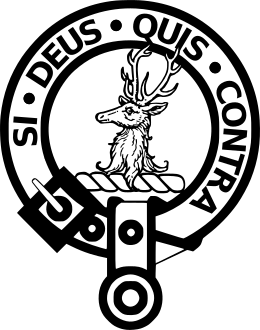Clan Spens facts for kids
Quick facts for kids Clan Spens |
|
|---|---|

Crest: A hart's head erased proper.
|
|
| Motto | SI DEUS QUIS CONTRA (from Latin: If God is for us, who is against us"). |
| Profile | |
| Region | Fife. |
| Chief | |
| Patrick Nathaniel George Spens. | |
| The 4th Baron Spens. | |
Clan Spens, also known as Spence, is a Scottish clan from the Lowlands region. It's also considered a sept of Clan MacDuff, which means they are a smaller group connected to the larger MacDuff clan.
Contents
History of Clan Spens
What Does the Name Spens Mean?
The name Spens or Spence comes from an old French word. It means someone who is a 'custodian' or 'dispenser,' like a manager or someone in charge of supplies.
How the Clan Began
The main Spens family in Scotland comes from the ancient Earls of Fife, who were powerful leaders.
One of the earliest known members was John 'Dispensator'. He was listed as a tenant of Walter fitz Alan, the Steward of Scotland, between 1161 and 1171. Later, Roger 'Dispensator' was a witness to an important document between 1202 and 1222. His son, Thomas 'Dispensator', also witnessed a charter in 1232.
In 1296, Henry de Spens, a feudal baron, swore loyalty to King Edward I of England. His name is on the Ragman Rolls from that year. Henry died around 1300, and his son, Thomas, took over. This Thomas is mentioned in two charters by King Robert the Bruce.
Later, William de Spens became the laird (landowner) of Gylgyrstoun and Glespany. In 1358, he received more lands, Dumbarnie and Bondiingtoune, from William Douglas, 1st Earl of Douglas. His son, also named William de Spens, married Isabel Campbell. Through this marriage, they received the lands of Athaland, Ketydy, and Craigswmqwar in 1385. These lands were later made into a barony in 1430, which meant they had special rights and status.
The Spens Family in the 1400s
By the early 1400s, the Spens family had become quite important. John Spens of Lathallan was even allowed to attend the Scottish Parliament in Perth in 1434. John married Isabel, from the Clan Wemyss, and they had three sons.
Their youngest son, Patrick, became an officer in the 24 bodyguards sent by King James II of Scotland to King Charles VII of France in 1450. Patrick settled in France, and his family became the important Barons de Spens d'Estignols in French nobility. These Scottish bodyguards were known as the "Garde Écossaise" and became the personal guards of the French kings until the French Revolution in 1789. King Charles VIII of France even adopted the Spens family motto, "Si Deus [pro nobis] quis contra [nos] ?" (If God is for us, who is against us?), in honor of Patrick.
Thomas Spens, the second son, joined the Church and rose to a very high position. He became the Bishop of Galloway and later the Lord Privy Seal, a powerful government role he held until 1470. He was known as a clever negotiator and was often sent on important state missions. For example, in 1449, he helped arrange a marriage for King James II's sister, Arabella. Two years later, he was an ambassador sent to negotiate a truce with England. Bishop Thomas Spens died in Edinburgh in 1480. You can see a statue of him in the beautiful chapel of Roslin.
The Spens Family and Mary, Queen of Scots
During the time of Mary, Queen of Scots, the Spens family had divided loyalties. Sir John Spence of Condie was the Lord Advocate (a top legal officer). He supported the new Protestant Church. When the Queen asked him to prosecute the reformer John Knox for treason, he didn't try very hard, and Knox was found not guilty.
However, David Spens of Wormieston was very loyal to Queen Mary. He was even declared a rebel by the Parliament in 1571. David was one of the leaders in a plan to capture Regent Lennox in Stirling in September of that year. David's job was to take the regent as a hostage. It's said that when some of the plotters wanted to kill the regent, David bravely threw himself in front of his prisoner to stop a pistol shot. When Lennox's supporters arrived, they killed David Spens on the spot, even though the regent tried to save him.
Later, the family made peace with King James VI of Scotland. King James sent Sir James Spens of Wormieston as an ambassador to Sweden. A branch of the Spens family settled there and became important members of the Swedish nobility as Counts Spens.
The Spens Family from the 1700s to the 1900s
Dr. Nathaniel Spens (1728–1815) was the second son of the 15th Laird of Lathallan. In 1792, he bought back Craigsanquhar in Fife, which had been owned by the family many years before. His descendant, Sir Patrick Spens (1885–1973), was made the 1st Lord Spens of Blairsanquhar, Fife, in 1959.
Dr. Nathaniel Spens of Craigsanquhar was also the president of the Royal College of Physicians in 1794. He was a well-known member of the Royal Company of Archers, who are the monarch's bodyguards in Scotland. A famous painting of him hangs in Archers' Hall in Edinburgh.
Another family member, Sir William Spens, was the vice-chancellor of Cambridge University from 1931 to 1933. John Spens, WS, was the Albany Herald to the Court of the Lord Lyon, King of Arms, which means he helped with Scottish heraldry and coats of arms.
Clan Chief Today
The current chief of Clan Spens is The Right Honourable The Lord Spens, Patrick Nathaniel George Spens. He is the 4th Baron Spens. His son, The Honourable Peter Lathallan Spens (born in 2000), is the next in line to be chief.

